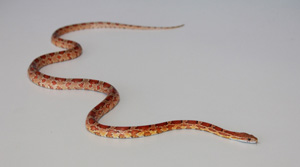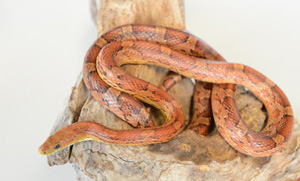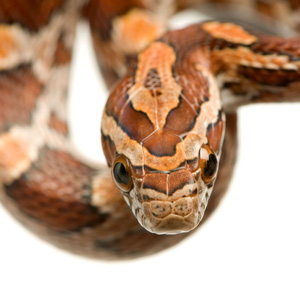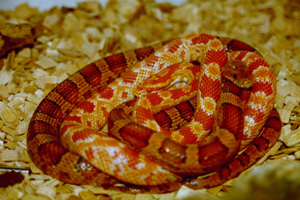Eastern corn snake
Pantherophis guttatus

Have you seen this animal? Report it now!
Photos and accurate descriptions of where and when the animal(s) was sighted are critical when making a report. Detailed information allows the Victorian Government to make a timely and positive identification. All reports are responded to as a priority and may result in trapping, surveillance and the removal of confirmed eastern corn snake.
You should never attempt to approach or handle a snake. All snakes should be considered venomous and highly dangerous. If bitten by a snake dial 000 immediately.
It's important to report eastern corn snake sightings
The eastern corn snake is not native to Australia and if given the opportunity could populate a wide range of landscapes within Victoria, impacting native species through predation and the introduction of new animal diseases.
Eastern corn snakes are classified as a controlled pest animal under the Victorian Catchment and Land Protection Act 1994. The importation, keeping, breeding and trading of this species, without appropriate permits, is illegal and penalties apply.
Eastern corn snakes have been found in all states in Australia, including Victoria, and are typically escapees or deliberately released animals from the illegal pet trade. Annually 1 to 2 eastern corn snakes are detected in Victoria by government officers. The illegal keeping and trading of eastern corn snakes poses one of the greatest risks of the species establishing in Victoria. Escapees or deliberately released animals can be extremely difficult and costly to recover.
How to identify an eastern corn snake
Size
Eastern corn snakes are relatively slender and are between 60 and 180 cm in length. Juveniles are similar to adults in appearance, hatchlings range in size from 22 to 36 cm.

Colour
They can have a wide range of colour variation and patterns, with the most common being the natural colouration of combinations of orange, red, brown with yellow and black. However, they can be white, red, yellow, red, black, greys and brown with a variety of patterns and markings.
Distinctive features
On their belly there are alternating rows of black and white marks, similar to a piano keyboard. The underside of the tail has two black stripes.

They have a spear-shaped pattern on their head and neck.

Habitat
They may be found in:
- wooded groves
- rocky hillsides
- meadowlands
- woodlots
- barns
- abandoned buildings.
Behaviour
They are primarily nocturnal. They readily climb trees, can be very secretive spending most of their time underground prowling through rodent burrows. During the day they hide under loose bark and beneath logs, rocks, and other debris. In cold areas, they hibernate during winter but may emerge to bask on warmer days.
Similar looking native snakes
Australian native snakes do not look similar to eastern corn snakes.
Impact on native species
Eastern corn snakes are a potential host for foreign pests and diseases, which could threaten native Australian and domestic animals. They can carry ticks that spread the bacterium Cowdria ruminatntium that can kill grazing animals.
Eastern corn snakes are generalist feeders, their diet is opportunistic and includes:
- amphibians
- lizards
- small mammals
- birds.
Prey is killed by constriction as they are non-venomous snakes. It is anticipated that Eastern corn snakes would compete for food with other Australian native reptiles.
